In the previous post, I noted that roleplaying combat can vary from storytelling to a pure tactical exercise, but that in all cases it is important that both the player and the GM have a reasonable idea of how skillful their character actually is. In short, and to invert the title of the post: you have to know the odds – even in a basically dramatic system.
Beat-Downs, Mechanics Style
Part I of this post dealt with D&D, Savage Worlds, and Night’s Black Agents. All use “roll vs. a fixed target,” and don’t encourage much active participation on the part of the defender. This article will discuss the two remaining systems (of the five on which I’ve chosen to focus), both of which do feature active defenses on the part of the target: Fate and GURPS.
Almost Certain to Succeed
More than once as we look at game mechanics, the concept of “almost certain to succeed” will appear. Somewhat arbitrarily, if a task has a 90% chance of success or better, the player will usually feel pretty confident in attempting the feat. As a result, the 90% breakpoint, as well as the 50% probability point where you will succeed as often as you fail, will be used to look at the influence of mechanics on success.
Fate
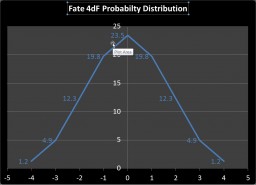
Keeping with the flavor that we left off with in the example of Night’s Black Agents, Fate is another strongly narrative game, but differs in many ways from the previous three systems, even as it comes to mechanics.
Firstly, Fate rolls special dice – specifically Fudge dice – which can have a value of -1, 0, or +1, with equal chances of each. These dice, which I’ve seen abbreviated dF, are rolled four at a time to judge a task, and added together – this produces a bell-shaped curve with the most likely outcome being zero, and varying from -4 to 4. The odds of rolling exactly a 3 (or -3) are about 5%, so it’s as likely as rolling a 1 or 20 on d20, and the odds of rolling 3 or 4 are 6.1%, so more or less one chance in 16.
Success comes in levels in Fate, but can also be treated as numerical results. I will tend to do that here, but there are four classes of outcomes. If your roll, adding skill and subtracting any opposition (which may be treated as a numerical penalty, or may be the result of a die roll from a foe) results in a negative number, you fail. If you wind up with zero, you tie. A positive number is a success, while success by 3 or more is “Succeeding with Style.”
Without getting into too much “this is how to play Fate” detail, the key bits are that if you’re using a skill on your character sheet (and assuming the basic character design method from Fate Core), you’ll have a bonus from +1 to +4 in it, averaging (in the skill pyramid version of Fate Core) +2. If you invoke an Aspect, you get another +2. As an example, Thor, God of Thunder, Worthy Wielder of Mjolnir (an important Aspect for the character), Self-proclaimed protector of Midgard, and Battle-Lord of Asgard might have +4 in Fight. If he wants to, as it might be said, put his hammer down, he will likely be rolling 4dF+6, since he’ll be invoking an aspect and is using his best skill. He will roll between 2 and 10, centered on a very, very good result of 6. This is a huge bonus – befitting our Thunder God.
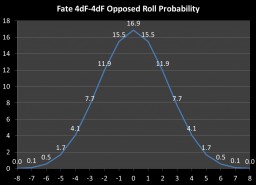
The other major difference between Fate and the prior three systems is that each attack is assumed to be countered with a defense action. In fact, of the four principle actions in Fate Core (Overcome, Create an Advantage, Attack, and Defend), two of them are obviously related to combat and always occur unless for some reason your foe cannot defend himself. This will usually be the same skill as used to attack – and in Fate Core, “Fight” covers an awful lot of ground! Differentiation can be found in the mixology of the narrative facets of the game, including Aspects and Stunts.
Probability-wise, though, the opposed 4dF rolls provide a range of outcomes from -8 to +8 – a very large (in Fate) swing in “shift” levels, but about 90% of the time, the results will wind up between -3 and 3. So, the odds of you getting a better die roll than your foe are determined – on dice alone, you’ve got about a 40% chance of actually getting a leg up on your foe.
How Awesome am I?
What that distribution implies, though, is that an awful lot depends on the absolute skill levels involved. If Thor (with a base +6 with Mjolnir in most cases) is fighting someone without much ability, say, +2 skill and not able to invoke an aspect, the basic difference translates directly into the results – the absolute “4 shift” delta between Thor and his foe means that the values work out well for our Thunder God: -4 to +12, and 90% of the time he’ll be +1 to +7. This translates into “smackdown imminent,” and suggests a final way to look at the results: Look at the difference in skill, and plot the chances of failure by 3+, success by 1, and success by 3+. As noted, skills will range from 0 to 4 during character creation, and Aspects can give a boost. I’ll focus on the range from -6 to 6 for skill delta, from “totally outclassed” to “you own the place,” more or less.
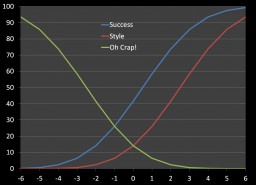
Every shift you can get from an Aspect, Boost, or skill delta counts, and counts huge. If you can outclass your foe on an attack by two shifts (say, the bonus you get from invoking an Aspect), you have more or less eliminated the chance of the defender succeeding with style, and you’re hitting more than two times in three. At four levels of difference, it’s all over but the bleeding.
Critical Thinking
Succeeding with Style is about as close you’ll get to a critical hit, and the benefits you get from multiple shifts are inherent – the result of your die roll is also your effect roll.
Parry! Dodge! Duck! Weave!
Fate Core is the first system of those considered where the foe’s opposition is active. You roll dice, and these influence the outcome. Roll well enough, and you can negate an otherwise successful roll on the attacker’s part. The book even suggests certain Stunts, such as a Riposte, where if you succeed with style on your defense, you can actually inflict two shifts of injury on your foe.
So defending, and defending well, can have both mechanical and dramatic consequences in a fight, and players can invoke Aspects, perform Stunts, or even go full-on defensive for +2 to the roll. And as noted, a two-level shift is a big deal when looking at the 4dF-4dF curve.
Mechanics aside, this (forgive the term) aspect of the game – actively responding to a threat with mechanical and narrative support – is a big boost to player agency. The feeling of being able to ‘do something’ rather than just stand there and take it is either loved (because it works out well for the players) or despised (because it can take a player’s perfectly good hit and invalidate it) it seems, but it’s definitely a distinguishing feature of the game.
That being said, having the defender roll his 4dF while the attacker rolls her own 4dF would be exactly the same as the attacker rolling 8dF, adding the skill delta, and then looking up the result. Minor shifts in skill delta, caused by invoking aspects or boosts, will shift the centerpoint, but there is no difference in the distribution of 4dF+4dF and 4dF-4dF. The inverse of a dF, or {1, 0, -1} is simply {-1, 0, 1} – that is, the exact same result.
So Fate provides a bit of the illusion of agency in randomness, simply by giving the same number from the dice pool to each player.
GURPS
The primary dice mechanic in GURPS is rolling 3d6 under a target number, which is the attacker’s modified skill. Sometimes heavily modified, since the dice themselves are not modified. This means that if you know the final skill or target, you know – exactly – the probability of success. The basic skill roll is based on 3d6, providing a range of rolls from 3-18. The bell-shaped curve will look familiar to that of the 4dF roll from Fate.
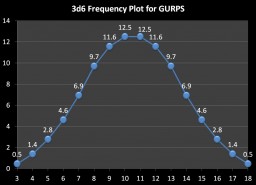
GURPS is a “roll-under” system, which means that rolling low for skills tests is a good thing. The higher the skill, the better the odds of rolling under that value on 3d6. There are few enough target numbers, and their probability is symmetric around 50%, that it’s pretty easy to memorize should you choose to do so.
Combat in GURPS uses two separate mechanics, and the most important of the two is the attack-defense pair of rolls. These are mostly independent, but not entirely. The basic method is that the attacker chooses the kind of attack he wants to do – and there are lots of options – and the defender chooses the kind of defense she wants to do. Each participant makes a choice and an independent skill roll.
As it happens, the attacker has lots of options. The player can choose on a spectrum (if he wants) from All-Out Attack, which gives a significant bonus to hit, at the cost of being unable to defend, to All-Out Defense, which (obviously) doesn’t allow attacking at all, but provides significant options for improving defenses. Even within something like All-Out, or if you’re using GURPS Martial Arts, Committed Attack lets you choose between options within that. A Determined attack gives a hit bonus, a Strong attack gives a damage bonus, and there are options for extending reach.
The key to all of this is that you can get very specific about what you’re doing. The system differentiates mechanically between (as examples) thrust and swing, different hit locations with unique effects, the spectrum of attack vigor between All-Out and Defensive (plus All-Out Defense, which of course isn’t an attack at all), plus the ability to layer options such as Rapid Strike (throw two attacks while maintaining defenses) or Deceptive Attack (take a penalty to your hit roll in exchange for a penalty to your foe’s defense roll).
And that matters. Because though each one carries a modifier to the character’s full skill, impacting the target number to roll under, your foe still mostly will get to roll his defense. The key concept here is that if you make your attack roll, you have thrown a good enough blow to hit your target – forcing your opponent to do something or take the hit.
Which he will certainly try and do.
Parry! Block! Dodge! Retreat! Sideslip!
In order to prevent smackdown, the defender gets an Active Defense roll. He can choose between getting out of the way (Dodge based on his Move score), a block, which is warding off a blow with a shield, or a parry, defined as using a weapon (or your arm!) to deflect the attack. The probabilities of a successful defense follow the same pattern as attacks – because the die rolls are never modified themselves.
That being said, the target number – that is, the adjusted skill for defenses – is quite different than on the attack. For one, it’s based on 3+Skill/2 for defenses, which for all skill levels higher than 6 will favor attack over defense. Dodge is a bit different, but ultimately, it’s a number, usually lower than raw attack skill, that can be used to counter an attack.
This Active Defense score (and we’ll focus on weapon and unarmed Parry here, but the general principles are the same for the other defenses, Block and Dodge) can be modified in similar ways to the attack. Backing off and giving ground gives a bonus. Too much carried weight gives a penalty to Dodge. A shield, in addition to enabling a block contributes a bonus to all active defenses. Certain Advantages can give bonuses to defenses, such as Combat Reflexes and the aptly named Enhanced Parry.
Importantly, if you have a lot of skill, the Deceptive Attack option allows you to lower your foe’s defenses. This is important, because as you might imagine, combining high skill (say, Broadsword-20) with lots of goodies can push defenses very high. Broadsword-20 has a base defense of 13, boosted by +1 for Combat Reflexes, and (say) another +2 for a medium shield . . . now you’ve got Parry-16, and the odds of rolling 16 or less on 3d6 is something like 98.1%, significantly above our “almost certain to succeed” threshold. If you get a chance to roll, you’ll succeed. Deceptive attack lets high skill counter high defense (though in this case, defenses will still be very high no matter what) to a certain extent.
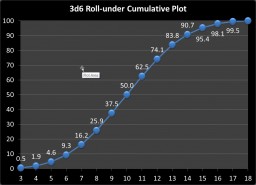
So ultimately, for straight-up bashing someone else with a stick or sword, a fighter’s chance of a successful blow is her odds of a successful hit roll multiplied by the probability that her foe fails her defenses.
The last interesting thing here is that in many cases, multiple defenses are penalized. While your first parry might be 16, your second is 12 and your third is 8. Unless, of course, you have wicked-cool BMF Advantages that make you more awesome.
How Awesome am I?
In GURPS your awesomeness is only somewhat in your own hands. That being said, if you’re looking at a 98% chance of hitting, you’ll strike home 90% of the time if your foe’s net skill is . . . Parry-6. That’s pretty low, and by and large you won’t find that in a stand-up fight.
What you will find is plenty of opportunities to weaken or lower your opponent’s defenses, and to some extent, your ability to do that is also part of your awesome. Leveraging a Judo Throw or Sweep to knock your foe prone for a -3 to defend is a big deal. Backing them tactically into a corner to deny a Retreat? Also good.
Critical Thinking
The other thing that high skill gets you in GURPS is the ability to roll a critical hit, which is always a roll of 3-4 regardless of skill, and can be a 5 at Skill-15 and 6 at Skill-16 or higher. If you roll a critical hit, not only does your foe not get to defend, but there are special effects, from double or triple damage to your foe dropping her weapon or falling down. Critical successes on defense rolls exist as well, and force your opponent to roll on a critical miss table, with anywhere from minimal to comical results.
Options, Options Everywhere . . . but gank him in the back!
The key bit of the mechanics from a “what are the odds” perspective is that, to some extent, trying to bludgeon or shoot your foe into oblivion is the not-so-gentle art of maximizing your bonuses while piling up penalties for the other party’s defenses. Or even better, arrange it through surprise or positioning, to eliminate the ability for the foe to see an attack coming at all.
Many Blows, Few Hits
The reason for this is simple, and important enough to mention in a post largely centered around dice probabilities and basic attack mechanics: A single hit can put you out of the fight, often regardless of skill.
There are no “levels” in GURPS, though there are point totals. If your super-experienced Navy SEAL gets shot in the vitals with a 9mm pistol, he’s human and he may die. Likewise with a sword or axe blow.
The key in GURPS is thus to not get hit (or have enough armor to ignore the hits!). This is accomplished tactically, by the use of active defenses with many options for making them better (or giving them up for other benefits, sometimes questionable – All-Out Attack, I’m looking at you). Getting hit a few times in GURPS with a real weapon (bows, guns, spears, cutting blades) will by and large render you incapacitated regardless of the skill level of your foe – if he can hit you, you’re in for it. This alters play dynamics quite a bit, especially combined with one-second turns.
But more on that in a different post.
Finish Him!
The two systems looked at today are based on actively defending against attacks.
In Fate, a system whose crunch is directed at narrative outcomes, the defense roll could potentially be lumped into a simple 8dF roll instead of two 4dF rolls (but it’s more fun to split the rolling), and a good roll on the defender’s part can impart significant negative consequences to the attacker.
In GURPS, a solid defense (or the inability to get attacked in return) is vital to survival, and a few actual telling hits will pretty much spell the end of most “mundane” foes. Sure, the GM can throw a Giant Bag of Hit Points at you, but real humans and animals tend not to be that way – and even a T-Rex (or more pedestrian, a Cape Buffalo) will die if you can reach the heart or vitals. GURPS allows the invocation of a vast sea of options – enough to surf on, or drown in, depending on comfort level.
To Each Their Own
I write for GURPS, and am, unsurprisingly, very comfortable with the system. When I GM, it’s my first choice. The depth of detail in description and the mechanical weight that can be brought to bear can make plausible verisimilitude soar to high heights. (Apologies to Dr. Seuss.)
That being said, I can easily see enjoying the heck out of all of these, in their own way. I play in a D&D5 game, and the new edition has managed to retain a lot of what I remember positively from far-too-long-ago, while streamlining the game and giving roleplaying mechanical weight. Night’s Black Agents is a few hundred pages of Ken Hite awesomeness, with fantastic tools for developing your campaign that can be ported, folded, spindled, and mutilated. The innovative part of the GUMSHOE engine has little to do with combat mechanics (and simulationists will run from the lack of resolution), but when played with an eye to “screen time” and cinematic flash can be fully engaging and engrossing. Fate will handle a degree of vagueness in character ability – for example, the ever-changing power lists of four-color comics characters – with a panache that most other systems that define abilities more precisely can’t quite manage. I’m the least experienced with Savage Worlds, but there’s always room for tactical play with a roll-and-shout feel. I got the same experience with the old d6 Star Wars system by West End Games (still one of my favorite game engines, and probably why I enjoy Fate as a concept so much). Each of these can be tremendous fun.
But you better know your odds.




